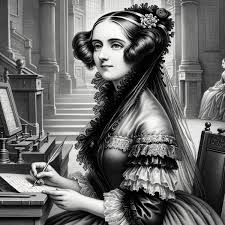Ada Lovelace’s programming vision, often celebrated as the world’s first computer programmer, was more than just a historical figure in the tech world. Her revolutionary ideas on the potential of computation laid the foundation for a future she would never witness. Despite her work being nearly two centuries old, many aspects of her vision remain underexplored and undervalued. Let’s dive into the lesser-known contributions of Ada Lovelace and unpack why her insights are still relevant today.
Who Was Ada Lovelace?
The Early Life of a Genius

Born in 1815, Augusta Ada King, Countess of Lovelace, was the daughter of the poet Lord Byron and Annabella Milbanke. While her father’s fame came from his poetic endeavors, her mother’s passion for mathematics profoundly shaped Ada’s future. From a young age, Ada exhibited an extraordinary aptitude for numbers and logic, earning her a place among the intellectual elite of Victorian society.
Collaboration with Charles Babbage
Ada’s most notable professional relationship was with Charles Babbage, the inventor of the Analytical Engine, an early mechanical computer. Their collaboration was groundbreaking; while Babbage envisioned the machine’s hardware, Ada foresaw its potential applications beyond pure calculation.
What Was Ada Lovelace’s Vision?
Beyond Number Crunching
Unlike her contemporaries, Ada believed that machines like the Analytical Engine could process more than just numbers. She theorized that they could manipulate symbols, making them capable of creating art, music, and more—a radical idea for her time.
A Revolutionary Note G
In her annotations to Babbage’s work, particularly Note G, Ada detailed how the Analytical Engine could calculate Bernoulli numbers. This algorithm is considered the first-ever computer program, demonstrating that machines could follow a sequence of operations to produce a desired result.
Bridging Science and Creativity
Ada’s vision blended science and the arts. She famously described her approach as “poetical science,” believing that imagination was as essential as logic in understanding the full potential of technology.
The Overlooked Aspects of Ada’s Contributions
Early Thoughts on Artificial Intelligence
While Ada doubted that machines could originate thoughts independently, she anticipated their potential to assist human creativity. This nuanced perspective foreshadowed debates in artificial intelligence and machine learning today.
The First Software Developer
Although Ada’s algorithm for the Analytical Engine is well-known, her role as the first software developer is often overshadowed by later figures in tech history. She not only wrote code but also predicted debugging challenges, emphasizing precision and foresight.
The Concept of Computational Universality
Ada hinted at ideas resembling computational universality the foundation of modern programming. She understood that a single machine could perform various tasks if programmed correctly, a concept formalized later by Alan Turing.
Why Is Ada Lovelace’s Vision Relevant Today?
The Intersection of STEM and the Humanities
Ada’s work demonstrates the power of interdisciplinary thinking. In today’s world, where STEM (Science, Technology, Engineering, and Mathematics) dominates, her integration of arts and sciences offers a model for fostering creativity and innovation.
Women in Tech: A Legacy
Ada’s achievements remind us of the vital role women have played in technology’s history. Her story inspires ongoing efforts to increase diversity in the tech industry, combating gender disparities that persist to this day.
A Precursor to Modern Computing
From music composition algorithms to AI art, modern applications echo Ada’s vision of machines as tools for creativity. Her insights continue to shape how we view the role of technology in our lives.
Unpacking Note G: A Deep Dive
The Algorithm Explained
In Note G, Ada outlined a step-by-step method for the Analytical Engine to compute Bernoulli numbers. This marked a critical shift from hardware-focused innovation to software-driven problem-solving.
Why It’s Revolutionary
Ada’s algorithm wasn’t just theoretical. It demonstrated that a machine could follow a sequence of instructions to achieve complex results, laying the groundwork for modern programming languages.
Ada’s Vision of Machines and Creativity
Machines as Musical Instruments
Ada imagined machines composing music, an idea that seemed fantastical at the time. Today, AI-driven tools like OpenAI’s MuseNet and Google’s Magenta make this a reality.
Art, Math, and Machines
Her belief in the artistic potential of machines anticipated generative art, where algorithms produce intricate, often stunning visual designs. Ada’s ideas resonate in every AI-generated artwork we see today.
The Legacy of Ada Lovelace
Recognition in a Male-Dominated Field
Ada’s contributions went largely unrecognized during her lifetime due to societal biases. Her resurgence as a tech icon underscores the importance of revisiting overlooked contributions.
Commemorative Efforts
Institutions like Ada Lovelace Day celebrate her legacy, aiming to inspire future generations of women in STEM. Her life serves as a reminder of the barriers women have historically faced in science and technology.
Ada in Pop Culture
From movies to novels, Ada’s story has inspired countless adaptations, further cementing her role as a pioneer and cultural icon.
Lessons from Ada Lovelace for Modern Innovators
Embrace Interdisciplinary Thinking
Ada’s ability to blend logic with imagination highlights the value of combining different fields to drive innovation.
Think Beyond the Obvious
Her foresight in recognizing the broader potential of computation reminds us to look beyond immediate applications and imagine what could be possible.
Overcome Bias and Barriers
Ada’s story illustrates the need to challenge societal norms and champion inclusivity in all fields.
How Ada’s Vision Shapes the Future
AI and Creativity
Her predictions about machines aiding creativity align closely with current AI applications. Tools like ChatGPT and DALL-E continue her legacy, blending computational power with human ingenuity.
The Importance of Imagination in Tech
Ada’s “poetical science” approach highlights that innovation requires not just technical skills but also a capacity for wonder and creativity.
The Need for Ethical Considerations
Ada’s insights into the limitations of machines remind us of the importance of ethical considerations in technology, particularly in areas like AI and automation.
Conclusion: A Legacy That Endures
Ada Lovelace’s vision was more than a product of her time; it was a blueprint for the future. Her ability to see beyond the immediate applications of technology and imagine its creative possibilities makes her an enduring figure in the history of innovation. As we navigate the complexities of modern computing, Ada’s work reminds us that at its heart, technology is a tool for amplifying human potential. By embracing her interdisciplinary approach and forward-thinking spirit, we can continue to push the boundaries of what’s possible.
Also Read: The Evolution of Military Governments in Nigeria: A Historical Perspective
FAQs
1. What did Ada Lovelace invent?
Ada Lovelace didn’t invent a physical machine but wrote the first algorithm intended for a machine the Analytical Engine. Her work is considered the foundation of programming.
2. Why is Ada Lovelace called the first programmer?
She earned this title because she created the first algorithm designed to be executed by a machine, showcasing how it could perform computations automatically.
3. How did Ada Lovelace’s vision influence AI?
Ada’s belief that machines could process symbols and assist in creativity paved the way for concepts foundational to artificial intelligence.
4. What is Note G in Ada Lovelace’s work?
Note G is part of her annotations on the Analytical Engine. It describes the first-ever algorithm, illustrating how the machine could calculate Bernoulli numbers.
5. Why is Ada Lovelace important today?
Her interdisciplinary approach to technology and creativity continues to inspire innovation in fields ranging from AI to generative art.


